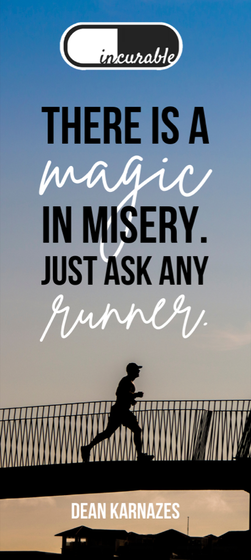|
Researchers have studied the strong connection between addiction and distance running, proving that many recovering addicts have a unique disposition for the sport. For many, one obsession is replaced by another (usually less destructive) one. The traits that can predispose a person to addiction can also produce fierce athletes. We hear less about runners who struggle with chronic pain. Of course, the cause of pain determines whether or not a chronic pain warrior is physically able to run without causing further damage. But those who continue to run through the pain, like those who have turned to running as an anti-drug, have a unique mindset and stamina that can lead to success in running and in life.
But what about endurance athletes who already live in a chronic pain state? The jury is still out on this one. We know that activities like running increase feel-good hormones that can help reduce pain, but further research is needed to explore the relationship between chronic pain, endurance and performance. As a runner who lives with chronic pain, I have my own theories. I think running appeals to me because it puts the ball back in my court. I didn’t choose chronic pain, but I can choose to run. And the pain associated with running is one that I can practice some control over with proper training, recovery and determination. That feeling of control, coupled with the mental fortitude required to run long distances with chronic pain, gives me a sense of power over my pain. Running isn’t an easy sport, and it certainly isn’t for everyone. But if you’re interested in giving it a try, keep in mind a few tips to start running as a chronic pain warrior: 1. Check with your doctor before you begin running or any new exercise program.Your doctor can help you decide if running is safe for you and may be able to give you some recommendations based on your diagnosis and current fitness level. 2. Pace yourself and progress slowly.A general rule of thumb for beginner runners is to increase your weekly mileage no more than 10% each week. Runners with chronic pain should be especially mindful of this rule and give their bodies extra time to adapt. 3. Make rest and recovery a priority.Any running routine, from the low-mileage beginner plan to an elite training regimen, requires adequate rest and recovery. Take time to listen to your body and don’t ignore any unusual aches or pains. There’s nothing wrong with taking a day off! Are you a runner with chronic pain? Share your tips in the comments!
0 Comments
Leave a Reply. |
My name is Maggie Morehart, and I'm the creator of Incurable. Learn more.
Categories
All
More Places to Find Me |



 RSS Feed
RSS Feed








